
- Definition Of Brand Development
- Importance Of Strategic Brand Development
- Branding Vs. Brand Development
- Stages Of Brand Development
- Implementing a Brand Strategy
- Types of Brand Development Strategies
- Critical Factors in Choosing Brand Strategy
- Examples Of Effective Brand Development
- What Does A Brand Development Manager Do?
- When Does A Brand Need To Be Redeveloped?
- The Risks Of Poor Brand Development
- Wrapping Up
- Key Takeaways:
What pops into your mind when you think of brands like Apple, Nike, or Coca-Cola? Do feelings of innovation, achievement, and joyful refreshment ring a bell? That instant familiarity and those associations represent the immense power of effective brand development.
But have you ever wondered — how these iconic brands grew from small startups into beloved powerhouse brands? Yes, having great products helped. But that’s only part of the secret sauce. The actual key was the long-term strategic brand development.
You’re probably thinking, “Isn’t that just logos, colors, and millions spent on advertising?” NO! Brand development dives far deeper to represent a company’s identity and soul. It encapsulates what a brand truly stands for and the unique value it brings to customers’ lives.
Strategic brand development transforms an average product into a cherished relationship that sticks around forever. Without it, even the most brilliant innovations may fall flat.
So, if you ever aspire beyond temporary fads and want to build an iconic brand that stands the test of time, master the brand development!
This guide will precisely walk you through brand development with practical steps and examples. Let’s get started!
Definition Of Brand Development
Brand development is strategically managing and growing a brand over time. The goal is to build lasting brand equity, spread awareness, connect emotionally with target customers, and stand out.
Unlike branding, which deals with logos and visuals, brand development looks at the bigger picture of positioning a brand to drive business growth.
It’s an ongoing process of understanding customers, defining the brand identity and promise, communicating it effectively, and adapting it when needed.
In simple terms, brand development shapes the identity representing a business’ vision, values, and personality. It encapsulates what a brand truly stands for, not just surface-level names and symbols.
The brand development process involves defining the following:
- Core identity: values, personality, positioning
- Promise: what customers can expect
- Messaging: verbal and visual brand language
- Customer experiences: interactions designed to convey the brand
When done right, brand development creates a clearly defined brand that resonates with target customers and fuels growth. It’s a way to set a brand apart in a crowded market strategically.
Importance Of Strategic Brand Development
Investing time and resources into thoughtful brand development matters for a few key reasons:
- Increases awareness and recognition
- Supports business growth objectives
- Attracts and retains more customers
- Builds brand equity and value
- Differentiates from competitors
Without intentional brand development, brands lack strategic direction. Their messages may need to be clarified for buyers or fully resonate. Brand development brings meaningful clarity and growth potential.
Branding Vs. Brand Development
Branding and brand development are connected but slightly different:
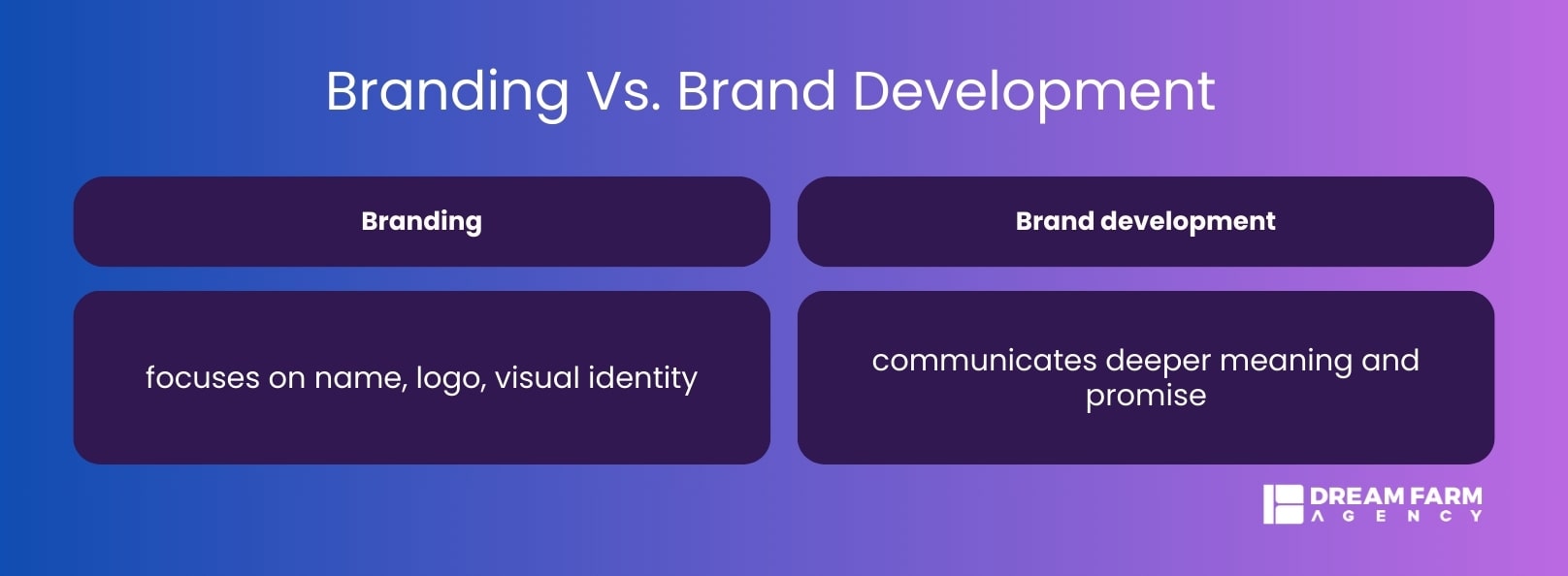
Strong branding provides recognition. Brand development drives deeper resonance by showcasing how a brand uniquely meets consumer needs and desires.
In To put it another way, you can view Brand development as a concept and branding as its implementation.
For example, Nike’s “Just Do It” slogan and Swoosh logo provide instant recognition (branding). But Nike also developed brand positioning around athletic perseverance and greatness that connects emotionally with target athletes on a deeper level.
Stages Of Brand Development
Developing a strategically impactful brand takes time. Building brand equity and connections with target consumers takes a planned, multi-phase process. While every brand’s process is slightly different, most follow these core strategic stages:
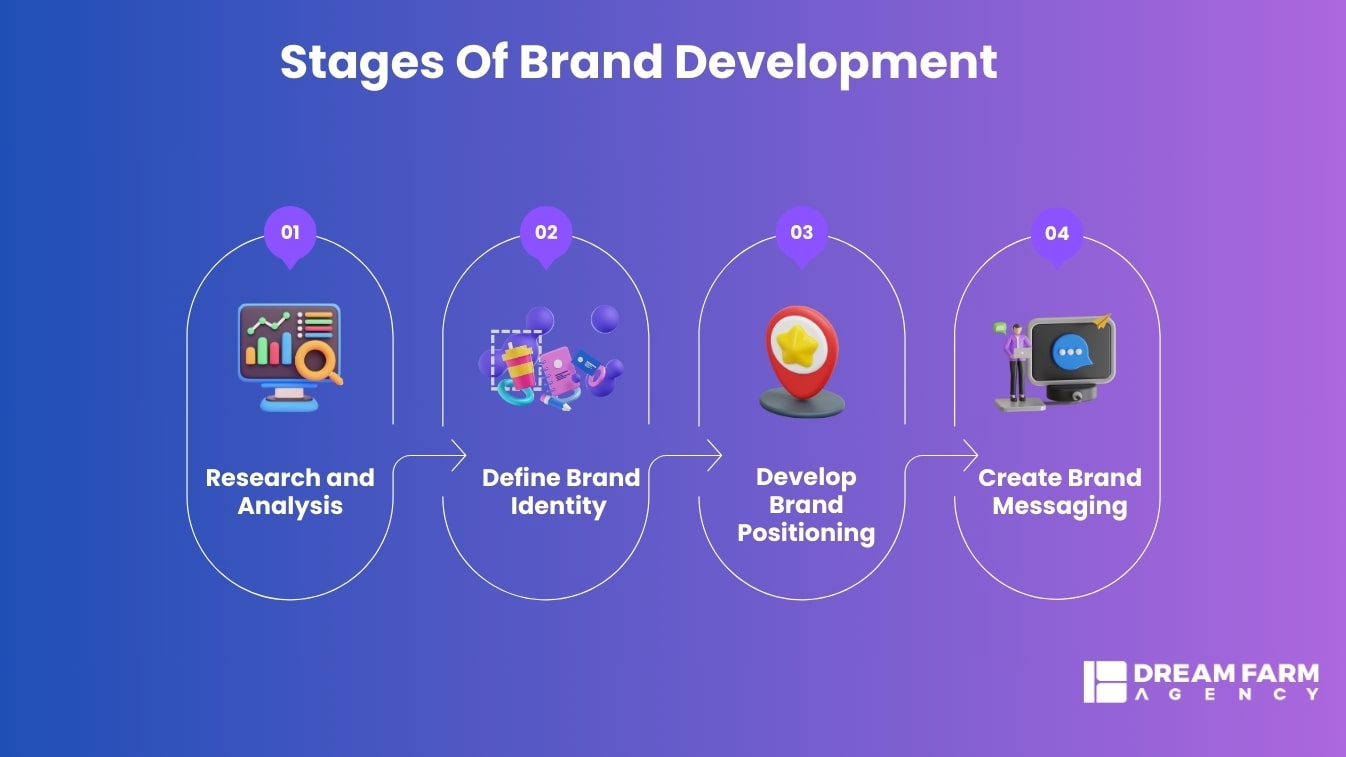
1. Research And Analysis
The first step in brand development is thoroughly understanding your target customers, competitors, and your existing brand perception. This research reveals critical insights to guide your branding decisions.
Understand Target Customers
Conduct surveys, interviews, and customer observations to build detailed “buyer personas” that capture:
Demographics: Age, gender, location, income level
Preferences: Interests, values, desired benefits
Pain points: Challenges they face, needs your brand could potentially solve
Getting to know potential customers is the most critical research task. A deep understanding of customer needs and wants drives every branding and messaging choice.
Study The Competition
- Identify direct competitors in your product category along with indirect substitutes.
- Analyze their branding, positioning, packaging, pricing, etc.
- Look for potential weaknesses or unmet consumer needs you could highlight.
Audit Existing Brand Perception
- Survey current customers and employees on brand familiarity, associations, trust, and satisfaction.
- Audit brand touchpoints like website, packaging, and ads to assess effectiveness in conveying brand identity and promise.
This initial research highlights gaps, opportunities, and insights to build an effective branding strategy around serving customer needs better than competitors. Keep the learnings accessible to guide later positioning and messaging decisions.
2. Define Brand Identity
The following essential step is establishing the core facets that will define your brand’s identity:
Brand Personality
Determine the distinctive characteristics and traits that embody your brand’s attitude and emotions. Your brand persona should feel like an approachable, exciting person that customers can relate to.
Examples:
- Down-to-earth, inventive, daring
Mission And Vision Statements
Craft mission and vision statements that summarize your brand’s reason for existing and where it aspires to go. These guide decisions.
Examples:
- Mission: “To inspire and nurture the human spirit – one person, one cup, and one neighborhood at a time.” (Starbucks)
- Vision: “Bring inspiration and innovation to every athlete in the world.” (Nike)
Core Values
Define the 3-5 essential beliefs and priorities that drive your brand’s behaviors and operations.
Examples: Integrity, sustainability, community
This brand identity foundation centered on personality, aspirations, and values informs later choices on positioning and messaging to ensure consistency. It acts as an uncompromising compass if tough decisions arise. Return to who you are at the core.
“Branding adds spirit and a soul to what would otherwise be a robotic, automated, generic price-value proposition. If branding is ultimately about the creation of human meaning, it follows logically that it is the humans who must ultimately provide it. Unless your brand is one of these exceptions, it needs energy!” David Aaker
3. Develop Brand Positioning
With your brand identity foundation clear, the next step is defining your competitive positioning. Determine:
Frame Of Reference
Specify the product or service category your brand competes in. This frames who your direct competitors are.
Example categories:
- Athletic shoes
- Coffee shops
- Smartphones
Points Of Parity
Describe how your brand meets the basic needs and expectations of all brands in your category. These are table stakes that customers take for granted.
Examples:
- Reasonable prices
- Convenient locations
- Decent product quality
Points Of Difference
Outline 3-5 meaningful ways your brand positively differentiates from competitors. What unique or better value do you provide target customers?
Examples:
- Superior taste
- Status and luxury associations
- Eco-friendly materials
This clear, succinct competitive positioning informs your marketing strategies and messaging priorities in the future. Lead with your strengths versus competitors.
4. Create Brand Messaging
With your brand identity and positioning defined, the next step is bringing your strategy to life through messaging that communicates:
Functional Benefits
Describe the practical solutions and functional value your brand offers customers.
Examples:
- Saves money
- Is more durable
- Helps people lose weight
Emotional Benefits
Convey the deeper feelings and meanings your brand enables customers to experience.
Examples:
- Feel more confident
- Enjoy feelings of nostalgia
- Achieve inner peace
Personality And Tone
Showcase your brand’s distinctive personality, voice, style, and character consistently across messages. Define the overall tone for communications.
Examples of tones:
- Witty/humorous
- Inspiring
- Authoritative
Impactful messaging clearly conveys the functional and emotional value you provide target customers in an authentic, memorable way.
“A product can be copied by a competitor; a brand is unique. A product can be quickly outdated; a successful brand is timeless.”
― David A. Aaker, Managing Brand Equity: Capitalizing on the Value of a Brand Name
Implementing a Brand Strategy
With a solid brand identity and messaging from the brand development process, the next crucial step is bringing that platform to life through customer experiences. Implementation is about embedding the brand throughout the organization across all touchpoints.
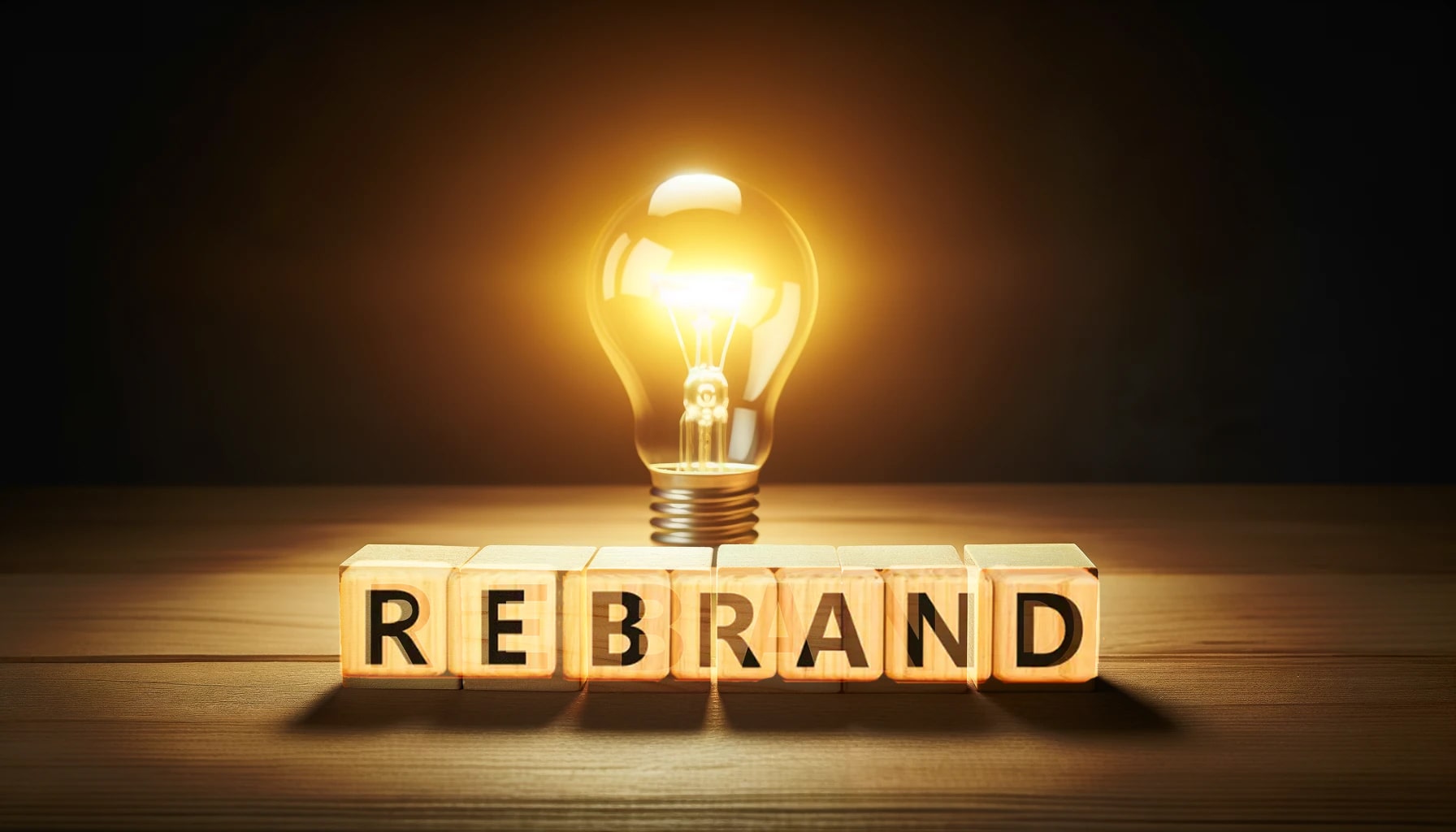
Integrate the Brand Identity Across Touchpoints
Every interaction or touchpoint between consumers and the brand should reinforce messaging and personality. Marketing campaigns play a significant role but cannot build a brand alone.
Holistic integration should happen across additional touchpoints like:
- Employees: The brand personality and tone should shape hiring, training, internal communications, recognition programs, etc. Employees become the face of the brand.
- Product packaging: Structural packaging design, materials, colors, and messaging should align with brand identity. Consider unique unboxing experiences.
- Service delivery: Ensure brand-aligned consistency across devices, platforms, and channels where customers engage with products/services.
- Online properties: Websites, social pages, communities, review sites, and more require monitoring and management to nurture positive brand perceptions. Respond and converse.
- Retail environments: Physical retail spaces, pop-ups, and event booths should immerse visitors in the brand’s look, language, and energy through environmental design, graphics, music, scents, and staff interactions.
Launch Updated Brand Assets
With brands becoming increasingly digital, launching a new website, mobile app, social channels, and marketing collateral fully encapsulating the brand purpose, personality, and visual identity is a primary implementation task.
Amplify Through Advertising and PR
Strategic advertising campaigns, public relations, and social media activations amplify brand awareness on top of integrated touchpoints. These initiatives showcase personality dimensions through bite-sized content and dramatic, creative executions.
Types of Brand Development Strategies
There are four main strategies companies use to build and grow brands:
- line extension
- brand extension
- multi-brands
- new brands
Let’s explore each strategy in detail.
Line Extension Strategy
A line extension is when a company introduces a new offering within an existing product category under a current brand name. Some examples of line extensions include:
- New flavors, colors, sizes, or formulations of an existing product. For example, Coke Zero is a line extension of Coca-Cola.
- New models or versions of an existing product. For example, the iPhone Pro is a line extension of the iPhone.
- New services or features added to an existing product. For example, Uber Eats is a line extension of Uber’s ride-hailing app.
Benefits Of Line Extensions
There are several potential benefits for companies that pursue a line extension strategy:
- Lower risk: Expanding an already successful brand with a line extension is generally lower risk than launching an entirely new brand. Consumers are already familiar with and trust the brand.
- Increased revenue: Line extensions allow brands to attract new customers, encourage more purchasing from existing customers, and charge premium prices. This expands total brand revenue.
- Market share growth: By offering more choices within a product category, brands can gain market share from competitors. The line extension draws in new customers.
- Optimized research and development: Product improvements and new formulations can be tested and launched faster and cheaper under an existing, trusted brand name.
- Increased distribution access: Retailers are often keen to stock line extensions from popular brands, giving brands access to new shelves and markets.
Risks Of Too Many Line Extensions
However, line extensions do come with some risks, especially if taken too far. Potential pitfalls include:
- Brand dilution: Expanding a brand into many different products can weaken brand identity and recognition. The brand loses its uniqueness.
- Consumer confusion: Too many line extension choices can overwhelm consumers and cause confusion about the brand’s core identity. This may turn customers away.
- Cannibalization: A line extension could attract customers away from the company’s existing products, hurting overall sales and profitability.
- Production complexity: Manufacturing and marketing a growing array of line extensions adds organizational complexity and cost. This weighs on profit margins.
Brand Extension Strategy
A brand extension is when a company uses an established brand name to launch new products in a different product category. For example, Amazon initially moved from selling only books to now selling electronics, cloud services, and grocery delivery.
Benefits Of Brand Extensions
Done right, brand extensions come with major upside:
- Increased brand awareness: A known brand name immediately boosts awareness for the new product launched under that name.
- Improved perception: A trusted, positive brand sentiment transfers to the new product, improving consumer perception.
- Cost efficiencies: Brand extensions allow companies to leverage existing distribution channels, marketing materials, manufacturing capabilities, and customer relationships.
- Higher success rate: One survey found that new products launched as brand extensions had an astounding 95% higher success rate than entirely new brands.
Risks Of Brand Extensions
However, brand extensions do pose some risks, such as:
- Brand dilution: Expanding to unrelated products can muddy and weaken a brand’s identity by spreading it too thin.
- Poor quality associations: If a brand extension fails or performs poorly in the market, it can damage consumer trust in the parent brand.
- Cannibalization: An extension could reduce sales of a company’s existing products if it appeals to the same customer base.
- Market confusion: Consumers may be confused or skeptical when longtime brands in one category suddenly offer products in very different categories.
Multi-Brand Strategy
A multi-brand strategy is when a company manages and markets several brands in the same product category. Each brand targets a distinct consumer segment even though the brands may compete for market share.
Benefits Of Multi-Branding
Pursuing a multi-brand strategy has many potential rewards:
- Unique positioning: Each brand can be positioned with messaging that resonates best with its target audience.
- Isolation from failure: If one brand fails or has a crisis, the parent company insulates other brands from damage.
- Market expansion: Expanding the number of brands increases a company’s market share across segments.
- Price segmentation: The company can offer brands at low-, mid-, and high-price tiers to capture a broader range of consumers.
- Acquisition platform: The parent company can acquire smaller brands cost-effectively.
For example, PepsiCo manages 20+ beverage brands, including Pepsi, Mountain Dew, Gatorade, SoBe, and Lipton Tea. Each targets distinct consumer segments, even within the beverage category.
Challenges Of Multi-Branding
However, managing multiple brands brings complications like:
- Increased marketing costs: Needed for brand-specific market research, positioning, packaging designs, advertising, and retail partnerships across a brand portfolio.
- Risk of internal competition & cannibalization: Multiple internal brands may eat into each others’ market share and undermine profitability. A careful segmentation strategy is required to grow each brand sustainably.
- Complex organizational structure: Maintaining separate brand management teams, marketing operations, and administrative needs for every brand adds costs.
So, pursuing a multi-brand strategy only makes sense if a company believes distinct brands work better to attract consumer niches than one mega-brand in a category.
New Brand Strategy
Companies launch entirely new brands when they believe a new brand will resonate better with potential new customers than extending an existing brand into a segment or category.
Reasons To Launch A New Brand
There are several strategic reasons companies introduce new brands:
- Fresh identity: A new brand presents a customized identity to win over new demographics and trends.
- Avoid baggage: Dropping legacy brand baggage that may have negative associations with new customers.
- Lock up distribution: In certain categories, limiting distribution is key. A new brand allows the company to pursue this.
- Price premium: Separate brands may allow the company to charge more premium pricing for similar products.
For example, Toyota launched its luxury brand Lexus with new dealerships and stricter distribution to command higher pricing and cater to the high-end market.
Learn more about Brand Strategy: What Is A Brand Strategy?
Benefits Of Introducing A New Brand
The upside of launching a new brand includes:
- New customers: Win demand from demographics who find existing corporate brands irrelevant or unattractive.
- Freedom to experiment: Creative freedom to test disruptive ideas, products, and services under a new brand.
- Renewed energy: The chance to leverage new branding, organizational structure, and strategies, as well as rebuild the culture.
- Insulation from risk: If the new brand fails, it doesn’t directly damage the core brand’s market credibility and consumer relationships.
Critical Factors in Choosing Brand Strategy
With four brand development strategy options on the table, how should companies analyze and decide their best path forward?
There is no one-size-fits-all universal answer. Branding decisions depend on each company’s unique situation and goals.
However, generally, companies should assess the following factors to inform strategic, data-driven decisions:
Target Market
- Research target audience demographics and purchasing trends
- Identify direct and indirect competitors
- Reveal potential market segment gaps and missing options
This analysis fully defines the target opportunity based on real market data and competitive dynamics.
Product Portfolio
- Review existing product lines’ performance
- Assess new products under development
- Gauge R&D capabilities to support new launches
The review honestly assesses the ability to create and deliver future products suited to the branding strategy under evaluation.
Brand Equity
- Measure existing brand awareness, sentiment, and partnerships
- Estimate marketing budgets needed for growth
These measures estimate existing brand strengths and positioning in the marketplace across variables.
Learn more about Brand Equity: What Is Brand Equity?
Growth Objectives
- Outline specific revenue and profit goals
- Set timelines for achieving growth targets
Leadership aligns around tangible targets, guiding decision-making trade-offs tied to each strategy.
Competition
- Evaluate competitors’ products, positioning, and brand strategies
- Identify threats imposing on growth goals
Deep competitor analysis exposes current and emerging threats likely to impact various brand strategy scenarios.
Analyzing all these factors together will guide an informed, data-driven decision aligned with corporate objectives.
Of course, the brand strategy must sync up with the company’s overall corporate strategy and business model at the end of the day. They should feed and reinforce one another.
Examples Of Effective Brand Development
Several brands stand out for excelling at long-term development strategies that build awareness and affinity by staying true to their core identity while adapting to new trends and consumer demands.
Starbucks
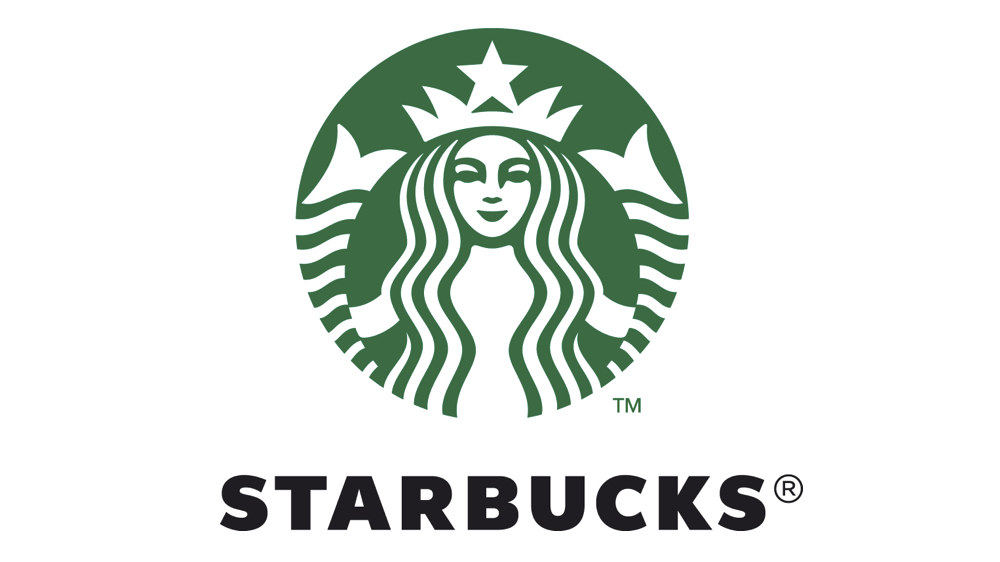
Starting from a single Seattle shop, Starbucks now represents the essence of the coffeehouse experience and community connection for millions globally. It built an empire through brand development strategies like:
- Defining brand personality: From the start, Starbucks carefully crafted an energetic but comforting/welcoming personality with values like connection and discovery.
- Creating experiences: Stores transformed buying coffee into an uplifting, resonating cultural experience. Adding WiFi and music furthered the community vibes.
- Introducing new offerings: Expansions into food, cold beverages, mobile ordering, and customization opened increased sales avenues without diluting equity.
- Embracing causes: Commitments to fair trade, sustainability, and social responsibility initiatives further emotional bonds.
Book Recommendation: Pour Your Heart Into It
This inspiring book details how Starbucks founder Howard Schultz poured his passion for high-quality coffee into building his company. Through persistence in the face of rejections and willingness to invest in infrastructure before immediate needs, Schultz grew Starbucks from a single shop to a global brand. However, Starbucks’ success lies in profits, nurturing trust with employees, and staying stubbornly devoted to its core values like coffee authenticity. The book advocates investing in people smarter than you and collaborating creatively to renew your brand. It offers valuable lessons for any entrepreneur on balancing growth, principles, and employee well-being. Overall, “Pour Your Heart Into It” provides an engaging case study of a visionary leader who turned an ordinary drink into an extraordinary business.
Nike

Since its start over 50 years ago, Nike has become synonymous with athletic excellence through brand development like:
- Tagline stickiness: The “Just Do It” tagline pithily captures aspirational achievement sensibility that persists decades later.
- Partnering with athletes: Endorsement deals with rising superstars like Michael Jordan and fuses the brand with sports greatness. Recent partnerships like Colin Kaepernick kept cultural relevance.
- Apparel innovation: Continual cutting-edge shoe designs and technology features reinforced functional benefits legitimacy.
- Brand consistency: Despite touching many sports and pop culture aspects, Nike resisted straying from an aspirational athlete identity.
Apple

Over 45 years, Apple grew from a startup to one of the world’s most valuable brands by strategies like:
- Cultivating brand loyalty: Apple borderline inspires religious devotion with “cult-like” followings. Community builds long-term connections.
- Hotel California strategy: While adding device options, Apple’s closed ecosystem makes it extremely hard for users to leave once immersed.
- Aesthetic focus: Apple won fans for industrial designs, adding beauty to electronics otherwise viewed as utilitarian.
Coca-Cola

Over 130 years, Coca-Cola has become the quintessential global refreshment brand through strategies like:
- Tagline resonance: “Taste the Feeling” continues a legacy of memorable, uplifting taglines capturing universal shared experiences.
- Meaningful traditions: Consistent brand elements like the Spencerian script logo, ribbon design, and annual holiday campaigns spark warm familiarity across generations.
- Local relevance: Adapting global marketing to reflect happiness and togetherness as locally understood gives worldwide consistency and local relevance.
- Purpose and sustainability: Expanding sustainability commitments and social impact programs fosters goodwill by tackling pressing societal challenges.
Tesla
In 15 years, Tesla has revolutionized automotive and renewable energy brands through moves like:
- Mission-focus: Centering the brand on sustainability and the aspiration to transition the world to zero-emission transportation gives it meaning beyond products.
- Luxury redefined: Modern, elegant vehicle design language combined with cutting-edge interfaces and autopilot reimagines transportation for the 21st century.
- Constant innovation: Continually advancing vehicle features, functionality, performance, and range makes the future feel present.
- Direct customer engagement: Communicating aspirations, achievements, and new offerings directly to customers through events and social media makes them feel invested in the mission.
Amazon
Over 25 years, Amazon has focused brand development on:
- Customer obsession: Interactions revolve around anticipating and delivering on customer needs through selection, speed, and convenience.
- Know me: Personalization features like tailored recommendations and Alexa cement direct customer relationships.
- Broadly trusted: Consistent delivery of brand promise across expanding categories fosters rare trust in brand quality.
- Prime ecosystem: Loyalty program creates frictionless, addictive convenience across integrated entertainment and shopping.
Harley-Davidson
For over 100 years, Harley-Davidson has built community through branding moves, including:
- Individuality: Fostering a brand personality centered on freedom, rebellion, and counterculture captures those who shape their path.
- Bonding: Sponsoring rallies and riding events tightens bonds, making owners feel part of one big global club united by shared passions.
- Custom culture: Continually expanding motorcycle customization and branded lifestyle apparel options help riders put their self-expression on full display.
Tiffany & Co.
Since 1837, Tiffany & Co. has defined timeless luxury branding through:
- Exquisite quality: Uncompromising standards for diamond sourcing and noble metal finishes cement industry leadership.
- Effortless glamour: Distinctive robin egg blue boxes and bags become recognizable status symbols even when hidden from view.
- Hollywood icon: Associating with celebrity and fame through appearances in movies and worn by starlets maintains aura.
There are countless brand examples we cannot cover here. Analyzing companies in your industry more deeply would offer further strategic insights.
Pick brands in growth or decline stages – from startups to global leaders. Identify the platforms and strategic choices that drive their journeys. Compare your ideas to what’s actually happened. You improve your skills by learning through application.
Some suggestions:
- Airbnb
- Dollar Shave Club
- IKEA
- Chipotle
- Old Spice
Taking a look at diverse brand examples, both wins and losses builds strategic intuition on what works.
What Does A Brand Development Manager Do?
A brand development manager is like a guardian angel for a company’s brand, guiding it through all stages of life. They nurture the brand from birth, help it find its voice during those awkward teenage years, and ensure it continues thriving even through messy adult growing pains.
Communication
- Creates briefs to convey brand guidelines for new products, marketing materials, and promotions to internal teams and external agencies
- Facilitates clear communication across departments like operations, finance, marketing, and product development to align on brand direction
Strategy
- Develops product line business plans and roadmaps tied to brand objectives
- Applies market and consumer research insights to guide branding and positioning decisions
- Sets and tracks performance metrics to measure brand health and growth
Execution
- Leads cross-functional teams to ensure brand consistency across touchpoints like packaging, marketing campaigns, digital platforms, and in-store displays
- Manages trademark, patent, and compliance processes to protect brand assets
- Oversees inventory planning and purchasing to support marketing launches
Evolution
- Monitors consumer trends and competitive forces to adapt brand messaging when needed
- Manages periodic brand refresh projects across visual identity, personality attributes, taglines, etc.
- Identifies new brand extension opportunities through licensing deals, partnerships, or acquisitions
The brand development manager plays a strategic role as the guardian of the brand by building equity over time through consistent, emotionally resonant messaging and experiences. They ensure the brand platform continues growing in strength and relevance amidst market changes.
When Does A Brand Need To Be Redeveloped?
Regular management lets brands adapt to incremental changes in consumer tastes or new innovations. Occasionally, whole industry landscape transformations or radical technology disruptions fundamentally challenge category dynamics and branding. Brands need redevelopment when they face these obstacles:
Significantly Shifting Consumer Expectations
New generations have fundamentally different beliefs, interaction preferences, and values that no amount of logo refresh or campaign boost can address since they’re too different from existing brand platforms. Branding rooted in analog-age assumptions risks being irrelevant to youth with fully formed digital habits.
Outdated Brand Identities and Messaging
Likewise, branding closely associated with cultural moments, trends, or stereotypes fades to obscurity as societies and collective sensibilities evolve regarding references and depictions once considered harmless, resulting in brands appearing “out-of-touch.” Over time, brand anchors that were originally considered clever or progressive become relics that are cringe-worthy. Unless more than cosmetic adjustments are made, adverse consumer reactions will slowly accumulate over time.
Loss of Target Audience Connection and Loyalty
When brand growth remains stagnant despite all management efforts, with awareness, consideration, active customer counts, share of wallet, and relative brand health metrics far below category averages or the brand’s historical baseline, the brand is suffering from foundational platform decay that is unlikely to be reversed without a redevelopment strategy.
In these scenarios, where the brand is disconnected from contemporary market needs, you can only reconnect with audiences by rebuilding brand architecture.
The Risks Of Poor Brand Development
Brands that thrive over the long term focus significantly on brand development and evolution. However, companies that neglect brand development jeopardize their stability and growth potential through:
Declining Brand Relevance and Equity
Brands failing to cultivate strong awareness, affinity, and trust with customers struggle to differentiate themselves from competitors. Instead, they risk declining into commodities that aren’t differentiated. This leaves them facing constant margin and sales pressures without premium profits or loyal customers to shield them during downturns.
Loss of Customer Trust and Loyalty
Brands thrive based on the awareness, affinity, and trust cultivated with their customers. Without strong brand development, companies risk fading into obscurity and becoming seen as interchangeable commodities by customers.
For example, failing to adapt branding to connect with changing generational preferences may cause a once-beloved brand to appear irrelevant or even offensive to youth customers. Brands must keep a pulse on cultural shifts.
Brands that betray promises to customers also erode loyalty. Fairtrade brands caught using exploitative suppliers or “healthy” food brands exposed for using harmful ingredients like excess sugar would violate established trust. Quality and transparency enable emotional bonds over time.
Missing Growth Opportunities
Companies miss significant growth opportunities when brand perception stagnates or declines due to poor branding management. These often rely on strong brand recognition and positive associations.
Without solid brands, businesses cannot successfully:
- Enter new adjacent product categories or global markets
- Launch brand licensing deals allowing third parties to use the brand on products for additional revenue
- Release new brand extensions like product lines or spinoff brands
For example, retailers may decline to carry an obscure product line extension without established brand demand. However, high-equity brands like Apple efficiently expand into categories like payments (Apple Pay) through brand halo effects. Brand development unlocks intrinsic growth paths.
Wrapping Up
Brands shape our world. The slogans, logos, and experiences of iconic brands like Apple, Nike, and Starbucks have become deeply ingrained into culture and our everyday lives.
These brands don’t just sell great products. Through meticulous brand development, they form emotional connections with us. We relate to their personalities. We aspire to what they represent. They capture our imaginations.
Strong brands fuel growth for companies by attracting loyal customers. But brand development goes far beyond expensive ads and flashy logos. It is a continuous, strategic process of positioning brands in our hearts and minds over time.
When done right, brands feel like trusted friends who understand us and have our back through life’s ups and downs. We gladly invite them into our homes and lives.
So don’t ever underestimate the immense power of brands. They influence our purchasing decisions and how we see ourselves and even shape cultural change. For visionary businesses, brands represent perhaps their most valuable asset of all.
We help you develop and design a strong brand. Our branding development service contains everything you need, from crafting a strategic brand foundation to activating your brand through marketing initiatives. Contact us today to discuss your brand goals!
Key Takeaways:
- Brand development builds emotional connections and competitive differentiation beyond visual branding.
- It requires extensive upfront research into target consumers and competitors.
- Core facets of identity act as branding guardrails over time
- Effective implementation brings positioning to life through organizational alignment
- Brands need ongoing management through evolution cycles to maintain relevance

Fareena
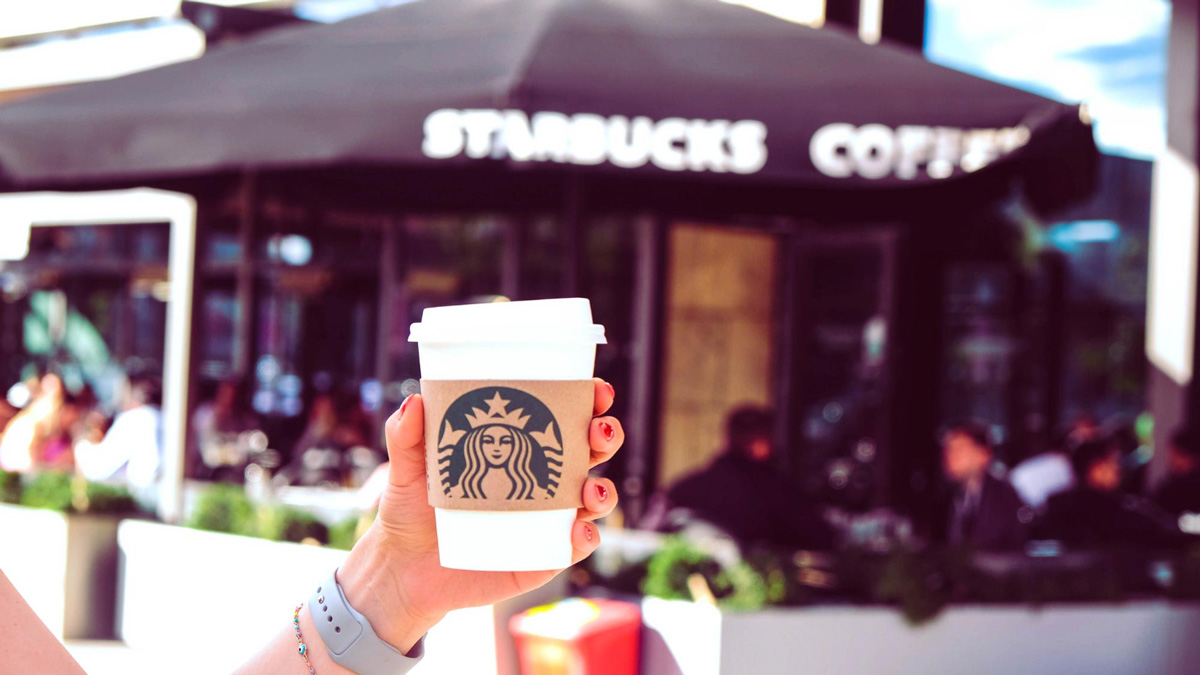



This was an insightful read! In my experience, involving the whole team in the brand development process has led to a more cohesive and authentic brand identity.